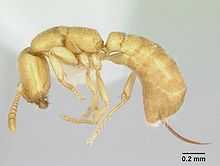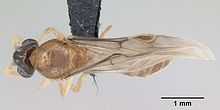Adetomyrma
| Adetomyrma | |
|---|---|
 | |
| A blind A. venatrix worker | |
 | |
| A winged A. venatrix queen | |
| Scientific classification | |
| Kingdom: | Animalia |
| Phylum: | Arthropoda |
| Class: | Insecta |
| Order: | Hymenoptera |
| Family: | Formicidae |
| Subfamily: | Amblyoponinae |
| Tribe: | Amblyoponini |
| Genus: | Adetomyrma Ward, 1994[1] |
| Type species | |
| Adetomyrma venatrix | |
| Diversity[2] | |
| 9 species | |
Adetomyrma is a genus of ants endemic to Madagascar. Workers of this genus are blind.[3] The type species Adetomyrma venatrix was described in 1994, with the genus being an atypical member of its tribe, the Amblyoponini. This tribe includes the dracula ants, members of which feed on the hemolymph of larvae.
Species
- Adetomyrma aureocuprea Yoshimura & Fisher, 2012
- Adetomyrma bressleri Yoshimura & Fisher, 2012
- Adetomyrma caputleae Yoshimura & Fisher, 2012
- Adetomyrma cassis Yoshimura & Fisher, 2012
- Adetomyrma caudapinniger Yoshimura & Fisher, 2012
- Adetomyrma cilium Yoshimura & Fisher, 2012
- Adetomyrma clarivida Yoshimura & Fisher, 2012
- Adetomyrma goblin Yoshimura & Fisher, 2012
- Adetomyrma venatrix Ward, 1994
Taxonomy
Adetomyrma was first described as a Malagasy endemic monotypic genus by Ward in 1994. Ward (1994) assigned this genus to Amblyoponini within the subfamily Ponerinae on the basis of the worker morphology of the type species Adetomyrma venatrix. Later, Bolton (2003) raised this tribe to subfamily status as Amblyoponinae.[4][3]
Biology
Members of the Amblyoponinae (especially Amblypone silvestrii) are called Dracula ants, after Count Dracula, the fictional vampire, referring to their unusual feeding habits; queens and workers practice a form of "non-destructive cannibalism", chewing holes into and feeding on the haemolymph (insect "blood") of the colony's own larvae. This behaviour, termed larval hemolymph feeding is thought to represent a precursor to trophallaxis, found in more derived ant species.[5][6]
The colonies, the first of which was found in a rotting log, may contain as many as 10,000 workers, winged males and several wingless queens (the majority of ant species feature winged queens). The workers use venom to stun their prey which are brought back to the colony for the larvae to feed upon. The colour of the winged males, a darker orange than the workers, suggests they disperse by flying to other colonies before mating.[1]
References
- ↑ 1.0 1.1 Ward, P. S. (1994). "Adetomyrma, an enigmatic new ant genus from Madagascar (Hymenoptera: Formicidae), and its implications for ant phylogeny". Systematic Entomology 19 (2): 159–175. doi:10.1111/j.1365-3113.1994.tb00585.x.
- ↑ Bolton, B. (2014). "Adetomyrma". AntCat. Retrieved 3 July 2014.
- ↑ 3.0 3.1 Yoshimura, Masashi; Fisher, Brian L. (2012), "A revision of the Malagasy endemic genus Adetomyrma (Hymenoptera: Formicidae: Amblyoponinae).", Zootaxa 3341: 1–31
- ↑ Bolton, B. (2003), "Synopsis and classification of Formicidae.", Memoirs of the American Entomological Institute 71: 1–370
- ↑ Saux, Corrie; Brian L. Fisher; Greg S. Spicer (2004). "Dracula ant phylogeny as inferred by nuclear 28S rDNA sequences and implications for ant systematics (Hymenoptera: Formicidae: Amblyoponinae)". Molecular Phylogenetics and Evolution 33 (2): 457–468. doi:10.1016/j.ympev.2004.06.017. PMID 15336679.
- ↑ Masuko, K. (1986). "Larval hemolymph feeding: a non-destructive parental cannibalism in the primitive ant Amblyopone silvestrii Wheeler (Hymenoptera: Formicidae)". Behav. Ecol. Sociobiol. 19 (4): 249–255. doi:10.1007/BF00300639.
 This article incorporates text from a scholarly publication published under a copyright license that allows anyone to reuse, revise, remix and redistribute the materials in any form for any purpose: Yoshimura, Masashi; Fisher, Brian L. (2012), "A revision of the Malagasy endemic genus Adetomyrma (Hymenoptera: Formicidae: Amblyoponinae).", Zootaxa 3341: 1–31 Please check the source for the exact licensing terms.
This article incorporates text from a scholarly publication published under a copyright license that allows anyone to reuse, revise, remix and redistribute the materials in any form for any purpose: Yoshimura, Masashi; Fisher, Brian L. (2012), "A revision of the Malagasy endemic genus Adetomyrma (Hymenoptera: Formicidae: Amblyoponinae).", Zootaxa 3341: 1–31 Please check the source for the exact licensing terms.
External links
 Media related to Adetomyrma at Wikimedia Commons
Media related to Adetomyrma at Wikimedia Commons Data related to Adetomyrma at Wikispecies
Data related to Adetomyrma at Wikispecies